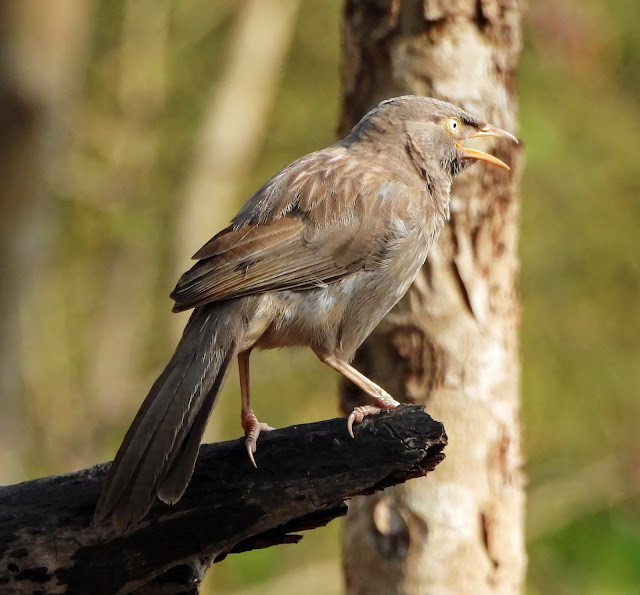The Bengal tiger (Panthera tigris tigris) is the nominate Tiger subspecies. It ranks among the biggest wild cats alive today. It is considered to belong to the world's charismatic megafauna. The Bengal tiger is estimated to have been present in the Indian subcontinent since the Late Pleistocene, for about 12,000 to 16,500 years. Today, it is threatened by a number of threats caused by humans.
The Bengal tiger's coat is yellow to light orange, with stripes ranging from dark brown to black; the belly and the interior parts of the limbs are white, and the tail is orange with black rings. The white tiger is a recessive mutant, which is reported in the wild from time to time in Assam, Bengal, Bihar, and especially in the former State of Rewa. However, it is not an occurrence of albinism. The Bengal tiger has exceptionally stout teeth. Its canines are 7.5 to 10 cm (3.0 to 3.9 in) long and thus the longest among all cats.
The Bengal tiger (Panthera tigris tigris) is the nominate Tiger subspecies. It ranks among the biggest wild cats alive today. It is considered to belong to the world's charismatic megafauna. The Bengal tiger is estimated to have been present in the Indian subcontinent since the Late Pleistocene, for about 12,000 to 16,500 years.
Today, it is threatened by a number of threats caused by humans.
The Bengal tiger's coat is yellow to light orange, with stripes ranging from dark brown to black; the belly and the interior parts of the limbs are white, and the tail is orange with black rings. The white tiger is a recessive mutant, which is reported in the wild from time to time in Assam, Bengal, Bihar, and especially in the former State of Rewa. However, it is not an occurrence of albinism. The Bengal tiger has exceptionally stout teeth. Its canines are 7.5 to 10 cm (3.0 to 3.9 in) long and thus the longest among all cats.
Bengal tigers lead solitary lives and congregate only temporarily when special conditions permit, such as plentiful supplies of food. The basic social unit of the tiger is composed of a female and her offspring. Resident adults of either sex maintain home ranges, confining their movements to definite habitats within which they satisfy their needs and those of their cubs, which include prey, water, and shelter.
On this site, they also maintain contact with other tigers, especially those of the opposite sex. Those sharing the same ground are well aware of each other's movements and activities. A male tiger keeps a large territory in order to include the home ranges of several females within its bounds, so that he may maintain mating rights with them. Territory disputes are usually solved by intimidation rather than outright violence.
Once dominance has been established, a male may tolerate a subordinate within his range, as long as they do not live in too close quarters. Tigers are thought to be mainly nocturnal predators, but they may also hunt in daylight. They generally hunt alone and ambush their prey as most other cats do. In most cases, tigers approach their victim from the side or behind from as close a distance as possible and grasp the prey's throat to kill it. Then they drag the carcass into cover, occasionally over several hundred meters, to consume it.
Tigers are strong swimmers and often bathe in ponds, lakes, and rivers, thus keeping cool in the heat of the day. They roar to signal their presence to other individuals over long distances and can be heard 3 km (1.9 mi) away. When tense, tigers will moan. For aggressive encounters, tigers growl, snarl, and hiss. Chuffing is heard in more friendly situations. Other vocalizations include grunts, woofs, and miaows.
Tigers are carnivores and prefer hunting large ungulates such as gaur, sambar, chital, barasingha, Water buffalo, nilgai, serow, and takin. Medium-sized prey includes Wild boar, Indian Hog deer, Indian muntjac, and Northern plains gray langur. Small prey such as porcupines, hares, and peafowl form a small part of their diet. Bengal tigers may sometimes hunt and kill predators such as the Indian leopard, mugger crocodile, Asian black bear, Sloth bear, and dhole.

They suckle for 3-6 months and begin to eat small amounts of solid food at about 2 months of age. At this time, they follow their mothers on their hunting expeditions and begin to take part in hunting at 5-6 months of age. At the age of 2-3 years, they slowly start to separate from the family group and become transient, looking out for an area, where they can establish their own home range. Young males move farther away from their native home range than young females. Once the family group has split, the mothers are ready to mate again. Young males reach maturity between 4 and 5 years of age, and females at 3-4 years.
%2020.jpg)
%2021.jpg)
%2020.jpg)
%2021.jpg)
%201.JPG)
%201.JPG)
%202.JPG)
%203.JPG)
%201.JPG)


%201.jpg)











%201.jpg)
%202.jpg)























%2020.jpg)
%2021.jpg)
%2022.jpg)